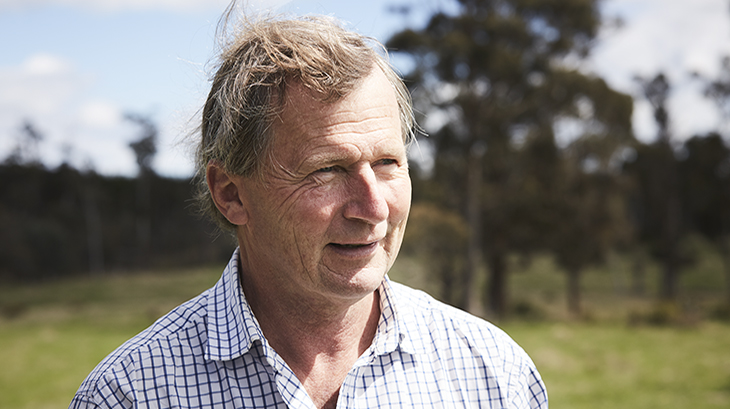Sustainability ‘complementary’ to the business of woolgrowing

Sixth generation producer Roderic O’Connor says improving sustainability goes hand-in-hand with increased profitability.
Six generations of Roderic O’Connor’s family have lived on 17,800ha ‘Connorville’ in Tasmania’s northern midlands for nearly 200 years, so a commitment to farming sustainably is in his DNA.
Today, Mr O’Connor keeps sustainability at the forefront of his thinking to ensure the farm survives and flourishes, that biodiversity is encouraged, the health of the planet is boosted, and he earns the ongoing social licence to be a farmer.
And he’s emphatic that improving the sustainability of his livestock enterprise goes hand-in-hand with increased profitability and efficiency.
Streamlined operation includes conservation covenant
“In the early 2000s we had a complex business that required a lot of staff – two sheep studs, a cattle stud, commercial beef and lamb flocks and a deer operation – but the enterprise wasn’t profitable,” Mr O’Connor said.
“We streamlined the whole operation so we now produce only prime lambs, fine wool and beef cattle. Around the same time, we signed the first conservation covenant with the Federal Government, and we now have about 23% of the property in a perpetual conservation covenant with only limited grazing.”
Decisions weren’t made lightly. Mr O’Connor believes it’s important to take the time to do some enterprise accounting to see what is and isn’t working.
“If you’re going to change your operation to make it more sustainable and productive, you really need to do your homework. We got a lot of traction when we modernised, but it was a big catch-up program,” he said.
“New technology has had an impact in every sector, from stock handling systems and yards, satellite technology in machinery, minimum tillage and fertiliser application down to the micro level. It’s been a quantum leap, particularly when combined with elements of rotational grazing and regenerative farming.”
Seasonal variation prompts investment in low stocking rates, irrigation
Strategic breeding, stocking rates, pivot irrigation systems and feed budgeting are just some of the ways the business has remained productive and profitable despite seasonal extremes at Connorville, which has an annual rainfall of 600mm.
Prime lambs are marketed mainly through the Coles GRAZE program for grassfed meat, which includes standards that cover feed and water as well as traceability, animal welfare and handling.
Stocking rates are low per paddock (ranging from 0.5 DSE/ha in conservation areas through to 50 DSE/ha elsewhere) and they aim to retain around 2,500kg of dry matter per hectare as a minimum through any season.
“We set stock our cattle but probably at 40% of the region’s average stocking rate, and we do a form of rotational grazing for sheep,” said Mr O’Connor.
“We also have a fairly large pivot irrigation project that we can use to dial up feed in a drought.”
The irrigation covers 900ha using centre pivots and a limited closed‑loop gravity system. While they’ve recently added another 700ML dam, the O’Connors only use around 15% of their total water licence capacity.
Feed budgets and strategic fertiliser maximises returns
“Spring and autumn has been erratic in the past decade, so we have to be very quick to respond. We’re doing things now that we never would have done 15 or 20 years ago, for example, such as fattening or holding more stock through.
“Managing our feed budget regularly is a basic way to stay resilient. I did a course on using MLA’s feed budgeting tool about five years ago and I’ve found this to be really useful for mapping our feed budget two to three months ahead,” Mr O’Connor said.
“Adjusting our fertiliser rates depending on land condition has also helped us maximise the productivity of our available feed base to the benefit of our livestock.”
Woolgrowers work to restore and conserve Midlands ‘Ark’
Connorville has been an active member of Greening Australia’s Tasmania Island Ark program due to its proximity to the Midlands region, which is one of only 15 National Biodiversity Hotspots in Australia.
The region has high concentrations of species that are threatened with extinction, such as the eastern barred bandicoot, the eastern bettong and several endangered orchid species.
In collaboration with local woolgrowers, Greening Australia has restored more than 1000ha through the planting of some 250,000 native plants in grassy woodlands and river flats, and an additional 200ha of existing native vegetation is being managed for conservation purposes.
“The Ark has been a very productive program. Large scale conservation is the way to go – small scale can fritter away a lot of connectivity. The Ark works well for farmers and the connecting corridors support the Midlands Hotspot,” said Mr O’Connor.
He sees his role as a nature conservationist not just as an aside to his profession as a woolgrower, but complementary in every respect.
“The only way to get more production out of your stock is to look after your land and look after the animals. Some people can do this easily, some can’t. But as a general rule, sustainability has to be at the forefront of your thinking because the public will demand it,” he said.
“At the end of the day it’ll do the planet good and you can get value from it, so you have to be aware and keep going down that road.”